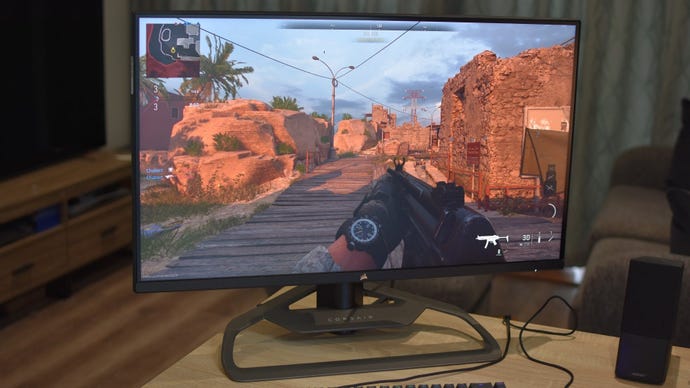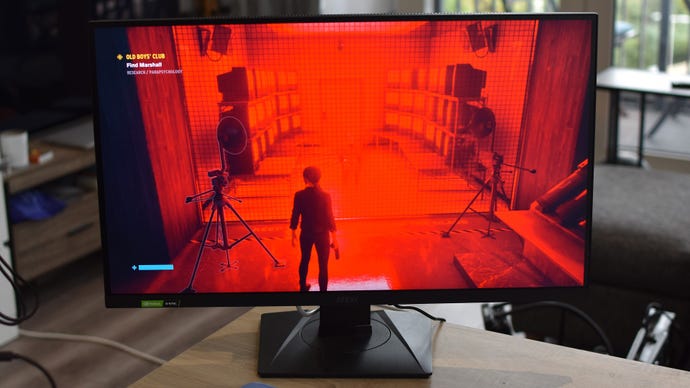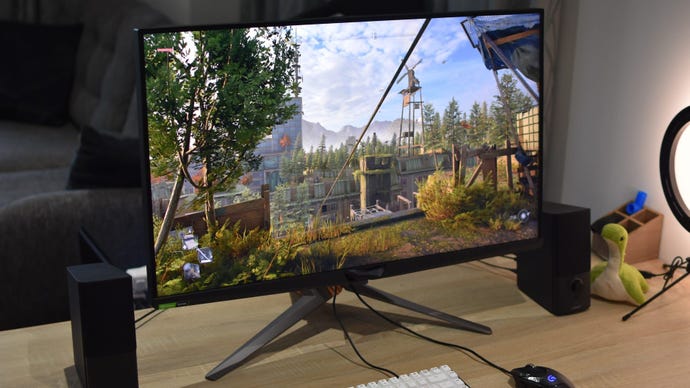The best 4K gaming monitors 2023
The top 4K displays we've tested
Upgrading to one of the best 4K gaming monitors could appear, in a year marked by furiously demanding games like Starfield and Alan Wake 2, to carry a degree of risk. 2160p play has always needed a beefy graphics card to push all those pixels, but is it worth making the switch when new releases might only run well on an absolute behemoth of a bleeding-edge PC?
Yes, in fact, it can be. You know what else looks good at a pin-sharp 4K? The thousands of other games you can play on PC besides the aforementioned GPU-melters. And even where those are concerned, there are more tricks and tools for getting them under control than there were when 4K monitors first became a viable gaming option. Upscalers like DLSS and FSR 2 are the most widely available, and newer versions – namely DLSS 3 and FSR 3 – can boost framerates further still. Far from this being a bad time to upgrade to 2160p, then, you could say it’s never been easier to get good performance at such a high resolution.
As for which 4K monitor to pick, this list will guide you through the best ones we've poked, prodded, and stared at intently in testing. You’ll notice it’s shorter than our guide to the best gaming monitors overall, but there’s still a surprising amount of variety to be found among these pixel-rich screens, from display size to panel technology and HDR support. You should find something to suit you, basically, even when you’ve not got the fattest budget to work with.
If you’re still unsure about what PC specs you need for 4K gaming, you can get by with at least a decent mid-range CPU, though I’d recommend at least an RTX 4070 Ti with DLSS 3 capability for a reliable combination of high quality settings and fast framerates. Should you be happy playing older fare, however, such a new GPU isn’t strictly necessary – something like an RTX 2080 or RTX 3070 (or their AMD equivalents) can handle upscaled 4K in plenty of games.
The best 4K gaming monitors 2023
- Corsair Xeneon 32UHD144 - the best 4K gaming monitor
- MSI MAG 274UPF - the best value 4K gaming monitor
- Asus ROG Swift PG32UQX - the best 4K gaming monitor for HDR
- Philips Evnia 42M2N8900 - the best TV-sized 4K gaming monitor
Corsair Xeneon 32UHD144
The best 4K gaming monitor
Here’s a list of everything I don’t like about the Corsair Xeneon 32UHD144: the stand is kind of big. That’s it. This is a big, bright, intensely vivid 4K/144Hz gaming monitor that’s a visible step up from mid-range alternatives while keeping the price... well, not low, but fair for the quality you’re getting.
There are a few colour profiles in the OSD (itself simple and easily usable with the rear-mounted joystick), but even the Standard mode is gorgeous. This covers 99.8% of the sRGB and 99.6% of the Adobe RGB gamuts, with a comfortable 1019:1 contrast ratio, so games always look as bold as they do sharp. There’s AMD FreeSync Premium support too, which morphs into effective Nvidia G-Sync compatibility when connected to a GeForce GPU.
HDR performance isn’t outright dazzling, but with a peak of 686cd/m2 in Final Fantasy XV, it’s brighter than most. And that desk hog of a stand is heavy-duty in a good way too, while offering ample adjustment for the main screen.
MSI MAG 274UPF
The best value 4K gaming monitor
Truly cheap 4K gaming monitors don't really exist, unless either they massively skimp on specs or you buy one secondhand, possibly out the back of an old Ford Transit. Nevertheless, the MSI MAG 274UPF costs remarkably little for a true gaming-spec, 144Hz model, and never looks like it’s cutting corners on performance. Motion is smooth and clean, sRGB gamut coverage hits 99.3%, and peak brightness in standard dynamic range is a beaming 489cd/m2. That climbed up to 519cd/m2 in Final Fantasy XV with HDR enabled, too.
It is on the smaller side of 4K monitors, at 27in diagonally, and its plastic-heavy build quality is unremarkable, so it can’t entirely pass itself off as a premium monitor in disguise. But then, it’s still got a decent stand with full height/tilt/pivot/rotation adjustment, and its set of connections extend to both USB-C and HDMI 2.1. It’s clearly no cut-price rush job, plastic or otherwise, and you even get a convenient joystick for OSD control instead of a fiddly row of buttons.
Ultimately, the MAG 274UPF delivers where it really counts, and proves you can get a good deal on a quality 4K gaming monitor without having to settle for static stands and 60Hz refresh rates.
Asus ROG Swift PG32UQX
The best 4K gaming monitor for HDR
Oof. That much for a single monitor? Indeed, the Asus ROG Swift PG32UQX is the opposite of accessible; if anything, it’s a statement of how far you’re willing to go to get hold of the latest tech.
That said, it’s also a very, very, very good 4K gaming monitor. Response times could be higher but everything I played looked glorious at 100fps+ 4K, and colour coverage and accuracy are truly top-tier. The ROG Swift PG32UQX is build to last too, with a reliable stable, adjustable and sharp-looking metallic stand.
What you’d really be paying for, though, is Mini LED backlighting. This is a generational upgrade on the crude edge backlighting you get on most IPS monitors, cramming thousands of tiny LEDs across the entire panel for a superior combination of high brightness, high contrast and bleed-free backlighting uniformity. Its brightness benefits are of particular use to games that support HDR, as the ROG Swift PG32UQX can tip over the 1000cd/m2 mark on bright spots without unintentionally lighting up any contrasting dark areas.
Read more in our Asus ROG Swift PG32UQX review
Philips Evnia 42M2N8900
The best TV-sized 4K gaming monitorNot only is the Philips Evnia 42M2N8900 a titan of a gaming monitor, it’s also an impressive early showing for OLED panel tech in a 4K gaming monitor. Perfect infinity: 1 contrast, 100% SRGB gamut coverage, and absolutely non-existent ghosting are OLED’s three big benefits here, giving games a sumptuous vibrancy.
That is, it should be said, in spite of its low brightness, so it’s not the best for HDR support. And OLED is higher-maintenance than IPS or VA, with the Evnia 42M2N8900 regularly wanting a screen refresh to prevent burn-in. To be clear, though, I don’t think it’s at serious risk of this: I could play shooters for hours without HUD elements searing into the screen in the process. Just don’t leave it on for days at a time and you’ll be fine.
Besides looking excellent, the Evnia 42M2N8900 also has the advantage of an adjustable stand: megasized monitors often go for a fixed set of feet instead, making it harder to set them up at a comfortable angle. And that’s just one of several hardware extras, from the reactive Ambiglow ambient lighting to its HDMI 2.1 connectivity. The latter will be useful if you want your TV-sized gaming monitor to indeed act as a TV, and connect to a 4K-capable games console as well as your PC.
Read more in our Philips Evnia 42M2N8900 review
Frequently asked questions
Why are lots of 4K gaming monitors only 60Hz?
It all comes down to how much bandwidth is available in your monitor's display inputs. It takes a lot of bandwidth to power a 4K display, especially once you throw HDR into the mix, and opting for more pixels often comes at the cost of a high refresh rate. For example, while HDMI 2.0 can quite happily support a refresh rate of 144Hz at 2560x1440, it's currently limited to just 60Hz when you move up to 3840x2160. DisplayPort 1.4, on the other hand, offers more bandwidth than HDMI 2.0, allowing up to a maximum of 120Hz at 3840x2160 with HDR - although some monitors will let you overclock them to 144Hz in their onboard menu settings. As a result, if you see a 4K monitor with a high refresh rate at the moment, there's a decent chance it can only manage that rate over DisplayPort. If you connect it to your PC over HDMI 2.0, you'll be stuck with 60Hz.
The good news is that HDMI 2.1 monitors, which allow for 120Hz refresh rates at 4K (and 144Hz with compression), have arrived. The world's first HDMI 2.1 gaming monitor, the Asus ROG Strix XG43UQ, launched in May 2021, with several more following it. DisplayPort 2.0 is also on the way, and should allow for 4K at 240Hz without compression, though we haven't seen any compatible gaming monitors announced yet (the Samsung Neo G8 uses compression to hit 240Hz).
Can a 4K monitor run at 1440p?
Yes. All you need to do is go to Windows' Display Settings, and set your Display Resolution to 2560x1440, as shown below.

Are 4K gaming monitors worth it?
With their high pixel count and sharp, crisp pixel densities, 4K monitors can be brilliant tools for everyday desktop work. They provide plenty of space for looking at several desktop applications at once, and they also make it much easier to see and juggle multiple windows in creative applications such as Adobe Photoshop and Premiere Pro. If you regularly use these kinds of apps in your everyday work life, 4K monitors are almost definitely going to be worth the extra investment over lower resolution displays.
That said, if your main reason for buying a 4K monitor is to simply play games at a 4K resolution, then you'll need to make sure you've got a powerful enough PC to really make the most of it. This can end up being quite the costly endeavour, as you'll need one of today's best graphics cards inside your PC in order to play them at a decent frame rate. I wouldn't try go any lower than the Nvidia GeForce RTX 3070 or AMD Radeon RX 6800, although if you want to play at higher quality settings, then you really want either an RTX 3080 or RX 6800 XT. Best of all would be an Nvidia RTX 40 series GPU, like the RTX 4070 Ti. These support DLSS 3, an upgraded version of the DLSS upscaler that can further boost framerates by adding in entirely AI-generated frames between the ones that your card is rendering normally. This makes for smoother motion, without putting more strain on the GPU's rendering capabilities.
Ironically, the cheapest way of getting a full-blown 4K gaming system in your house is probably buying an Xbox Series X or PlayStation 5. As we found out when we tried to build an equivalent Xbox Series X PC, we would have had to spend almost £1500 to get the same kind of 4K gaming chops as the Series X, which is over a grand more than what the console costs. In this sense, the question of whether 4K gaming monitors are 'worth it' depends very much on how badly you want to play games at this resolution, and how much you're willing to spend in order to get there.
Of course, there's nothing wrong with buying a 4K monitor and then using it to play games at 1440p. If anything, it gives you even more flexibility than lower resolution screens, especially if you're in the process of trying to upgrade your PC at the moment, or you're waiting for graphics card prices to come back down to normal again. And, even though 1440p is arguably more of a sweet spot for games in terms of balancing sharpness and performance, 4K monitors are much better for everyday desktop tasks, you'll likely thank yourself later for getting a screen with more pixel real estate.






